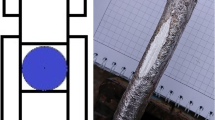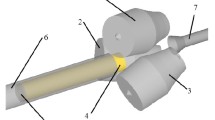Abstract
A simulation of the direct extrusion method of large-size rods with diameters of 188, 214, 252, 283, 326, and 560 mm made of alloy 7075; coefficients of friction of 0 and 0.5; and die cone angles of 80° and 90° from a container with a diameter of 800 mm using a 200-MN press with the help of the DEFORM-2D software package is performed. The distribution of radial velocities of metal flow on a working surface of a pressure pad depending on the contact friction, die cone angle, and elongation ratio at the main and final stages of extrusion is found. The butt-end height at the beginning instant of funnel formation is accepted equal to the distance between the pressure pad plane and input plane of extruded metal into a screw channel of flat or cone dies. The combined effect of the elongation ratio, coefficient of friction, and die cone angle on the butt-end height, extrusion force, intensities of strain rates and stresses, and temperature on the die orifice edge is investigated. Numerical experiments are performed according to the complete factorial plan 23 for variability intervals of parameters: Х1 = 3–9, Х2 = 0–0.5, Х3 = 80°–90°. Friction between the tool and the billet at the final stage of extrusion plays a negative role, noticeably decreasing the radial velocity. This leads to the earlier onset of the formation of the central funnel. Extrusion into a conical die and an increase in the elongation ratio, on the contrary, increase the radial flow velocity and provide the later onset of formation of a central funnel. The main factor that determines the butt-end height is the elongation ratio. A mathematical model is proposed to select the butt-end thickness for concrete extrusion conditions of large-dimensioned rods with small elongation ratios.



Similar content being viewed by others
REFERENCES
Lukashenko, V.N., Justification of the expediency of pressing with drawing coefficient λ < 10, Tekhnol. Llegk. Splav., 1980, no. 5, pp. 11–14.
Kargin, V.R. and Deryabin, A.Y., Characteristics of large bars extruding using small extrusion ratio, Key Eng. Mater., 2016, vol. 644, pp. 211–217.
Perlin, I.L. and Raitbarg, L.Kh., Teoriya pressovaniya metallov (Theory of Metal Pressing), Moscow: Metallurgiya, 1975.
Bauser, M., Sauer, G., and Siegert, K., Extrusion, USA: ASM International, 2006, 2nd ed.
Pradip K. Saha, Aluminum Extrusion Technology, USA: ASM International, 2000.
Wojciech Z. Misiolek and Richard M. Kelly, Extrusion of aluminum alloys. URL: https://materialsdata.nist.gov/ bitstream/handle/11115/164/Extrusion%20of%20Al%20 Alloys.pdf?sequence=3 (accessed February 15, 2018).
Pearson, C.E., The extrusion of metals, London: Metal Industry,1960.
Sheppard, T., Extrusion of Aluminum Alloys, Dordrecht, Boston, London: Kliwer, 1999.
Zinov’ev, A.V., Kolpashnikov, A.I., Polukhin, P.I., and Glebov, Yu.P., Tekhnologiya obrabotki davleniem tsvetnykh metallov i splavov (Technology of Pressure Treatment of Nonferrous Metals and Alloys), Moscow: Metallurgiya, 1992.
Loginov, Yu.N., Pressovanie kak metod intensivnoi deformatsii metallov i splavov (Pressing as a Method of Intensive Deformation of Metals and Alloys), Ekaterinburg: Ural. Federal. Univ., 2016.
Galatskaya, I.K., Metallografiya metallurgicheskikh defektov v pressovannykh polufabrikatakh iz alyuminievykh splavov (Metallography of Metallurgical Defects in Pressed Semifinished Products of Aluminum Alloys), Kuibyshev: Kuibyshev. Knizh. Izd., 1973.
Riyadi Tri Widodo Besar and Siswanto Waluyo Adi, The use Abaqus for teaching the development of cavity defects in forward extrusion processes, Int. J. Mech. Eng. Edikat., 2008, vol. 36, no. 3, pp. 221–224.
Grabarnik, L.M. and Nagaitsev, A.A., Pressovanie tsvetnykh metallov i splavov (Pressing of Nonferrous Metals and Alloys), Moscow: Metallurgiya, 1991.
Shcherba, V.N. and Raitbarg, L.Kh., Tekhnologiya pressovaniya metallov (Technology of Metal Pressing), Moscow: Metallurgiya, 1995.
Loginov Yu.N., Ershov A.A. Modeling in the QFORM software complex the formation of press sagging during pressing, Kuzn.-Shtamp. Proizvod. Obrab. Met. Davl., 2013, no. 7, pp. 42–46.
Belyaev, A.P., Zaitsev, A.P., Lositskii, A.F., Nozdrin, I.V., Ogurtsov, A.N., and Savel’ev, V.N., RF Patent 2151013, 2000.
Kargin, V.R. and Egorov, I.A., RF Patent 2492013, 2013.
Biswas Amit Kumar and Leventer Robert, US Patent 3919873, 1975.
Loginov, Yu.N., RF Patent 230699, 2007.
Parvizian, F., Kayser, T., Horting, C., and Svendsen, B., Thermomechanical modeling and simulation of materials processing technology, (Journal name missed) 2009, no. 209, pp. 876–883.
Libura, W. and Rękas, A., Numerical modelling in designing aluminium extrusion, in: Aluminum Alloys: New Trends in Fabrication and Applications, Zaki Ahmad, Ed., In Tech, 2012, pp. 137–157. https://www.intechopen.com/ books/aluminium-alloys-new-trends-in-fabrication-and-applications/numerical-modelling-in-designing-aluminium-extrusion (accessed February 15, 2018).
Stebunov, S., Biba, N., Lishny, A., and Jiao, L., Practical implementation of numerical modeling to optimization of extrusion die design for production of complex shape profiles, Alum. Extrus. Finish., 2013, no. 4, pp. 20–24.
Kargin, V.R., Bykov, A.P., Kargin, B.V., and Erisov, Ya.A., Modelirovanie protsessov obrabotki metallov davleniem v programme DEFORM-2D (Simulation of Metal Forming Processes in the DEFORM-2D Program), Samara: MIR, 2010.
Sawtell, R.R. and Staley, J.T., Interactions between quenching and aging in allow 7075, J. Alum., 1983, no. 2, pp. 127–133.
Adler, Yu.P., Markova, E.V., and Granovskii, Yu.V., Planirovanie eksperimenta pri poiske optimal’nykh uslovii (Planning an Experiment when Searching for Optimal Conditions), Moscow: Nauka, 1976.
Author information
Authors and Affiliations
Corresponding authors
Additional information
Translated by N. Korovin
About this article
Cite this article
Kargin, V.R., Deryabin, A.Y. Simulation of the Final Stage of the Direct Extrusion Method of Large-Size Rods at Small Elongations. Russ. J. Non-ferrous Metals 59, 632–636 (2018). https://doi.org/10.3103/S106782121806007X
Received:
Revised:
Accepted:
Published:
Issue Date:
DOI: https://doi.org/10.3103/S106782121806007X




